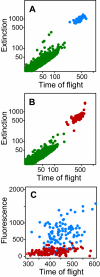Effects of genetic mutations and chemical exposures on Caenorhabditis elegans feeding: evaluation of a novel, high-throughput screening assay
- PMID: 18060055
- PMCID: PMC2092392
- DOI: 10.1371/journal.pone.0001259
Effects of genetic mutations and chemical exposures on Caenorhabditis elegans feeding: evaluation of a novel, high-throughput screening assay
Abstract
Background: Government agencies have defined a need to reduce, refine or replace current mammalian-based bioassays with testing methods that use alternative species. Invertebrate species, such as Caenorhabditis elegans, provide an attractive option because of their short life cycles, inexpensive maintenance, and high degree of evolutionary conservation with higher eukaryotes. The C. elegans pharynx is a favorable model for studying neuromuscular function, and the effects of chemicals on neuromuscular activity, i.e., feeding. Current feeding methodologies, however, are labor intensive and only semi-quantitative.
Methodology/principal findings: Here a high-throughput assay is described that uses flow cytometry to measure C. elegans feeding by determining the size and intestinal fluorescence of hundreds of nematodes after exposure to fluorescent-labeled microspheres. This assay was validated by quantifying fluorescence in feeding-defective C. elegans (eat mutants), and by exposing wild-type nematodes to the neuroactive compounds, serotonin and arecoline. The eat mutations previously determined to cause slow pumping rates exhibited the lowest feeding levels with our assay. Concentration-dependent increases in feeding levels after serotonin exposures were dependent on food availability, while feeding levels decreased in arecoline-exposed nematodes regardless of the presence of food. The effects of the environmental contaminants, cadmium chloride and chlorpyrifos, on wild-type C. elegans feeding were then used to demonstrate an application of the feeding assay. Cadmium exposures above 200 microM led to a sharp drop in feeding levels. Feeding of chlorpyrifos-exposed nematodes decreased in a concentration-dependent fashion with an EC(50) of 2 microM.
Conclusions/significance: The C. elegans fluorescence microsphere feeding assay is a rapid, reliable method for the assessment of neurotoxic effects of pharmaceutical drugs, industrial chemicals or environmental agents. This assay may also be applicable to large scale genetic or RNAi screens used to identify genes that are necessary for the development or function of the pharynx or other neuromuscular systems.
Conflict of interest statement
Figures




Similar articles
-
Automatically tracking feeding behavior in populations of foraging C. elegans.Elife. 2022 Sep 9;11:e77252. doi: 10.7554/eLife.77252. Elife. 2022. PMID: 36083280 Free PMC article.
-
Serotonergic modulation of feeding behavior in Caenorhabditis elegans and other related nematodes.Neurosci Res. 2020 May;154:9-19. doi: 10.1016/j.neures.2019.04.006. Epub 2019 Apr 24. Neurosci Res. 2020. PMID: 31028772 Review.
-
In silico molecular comparisons of C. elegans and mammalian pharmacology identify distinct targets that regulate feeding.PLoS Biol. 2013 Nov;11(11):e1001712. doi: 10.1371/journal.pbio.1001712. Epub 2013 Nov 19. PLoS Biol. 2013. PMID: 24260022 Free PMC article.
-
The effects of metals and food availability on the behavior of Caenorhabditis elegans.Environ Toxicol Chem. 2003 Dec;22(12):3049-55. doi: 10.1897/02-565. Environ Toxicol Chem. 2003. PMID: 14713049
-
Toxicity testing of neurotoxic pesticides in Caenorhabditis elegans.J Toxicol Environ Health B Crit Rev. 2014;17(5):284-306. doi: 10.1080/10937404.2014.933722. J Toxicol Environ Health B Crit Rev. 2014. PMID: 25205216 Review.
Cited by
-
Pharmacological Profiling of a Brugia malayi Muscarinic Acetylcholine Receptor as a Putative Antiparasitic Target.Antimicrob Agents Chemother. 2023 Jan 24;67(1):e0118822. doi: 10.1128/aac.01188-22. Epub 2023 Jan 5. Antimicrob Agents Chemother. 2023. PMID: 36602350 Free PMC article.
-
Toxicity ranking of heavy metals with screening method using adult Caenorhabditis elegans and propidium iodide replicates toxicity ranking in rat.Food Chem Toxicol. 2012 Sep;50(9):3280-90. doi: 10.1016/j.fct.2012.06.051. Epub 2012 Jul 4. Food Chem Toxicol. 2012. PMID: 22771366 Free PMC article.
-
Xenobiotic metabolism and transport in Caenorhabditis elegans.J Toxicol Environ Health B Crit Rev. 2021 Feb 17;24(2):51-94. doi: 10.1080/10937404.2021.1884921. Epub 2021 Feb 22. J Toxicol Environ Health B Crit Rev. 2021. PMID: 33616007 Free PMC article. Review.
-
Detoxification and sensing mechanisms are of similar importance for Cd resistance in Caenorhabditis elegans.Heliyon. 2016 Oct 27;2(10):e00183. doi: 10.1016/j.heliyon.2016.e00183. eCollection 2016 Oct. Heliyon. 2016. PMID: 27822562 Free PMC article.
-
Comparative toxicology of mercurials in Caenorhabditis elegans.Environ Toxicol Chem. 2011 Sep;30(9):2135-41. doi: 10.1002/etc.603. Epub 2011 Jul 11. Environ Toxicol Chem. 2011. PMID: 21692103 Free PMC article.
References
-
- Becker RA, Borgert CJ, Webb S, Ansell J, Amundson S, et al. Report of an ISRTP workshop: progress and barriers to incorporating alternative toxicological methods in the U.S. Regul Toxicol Pharmacol. 2006;46:18–22. - PubMed
-
- Culetto E, Sattelle DB. A role for Caenorhabditis elegans in understanding the function and interactions of human disease genes. Hum Mol Genet. 2000;9:869–877. - PubMed
-
- Croll NA. Indolealkylamines in the coordination of nematode behavioral activities. Can J Zool. 1975;53:894–903. - PubMed
Publication types
MeSH terms
Grants and funding
LinkOut - more resources
Full Text Sources

